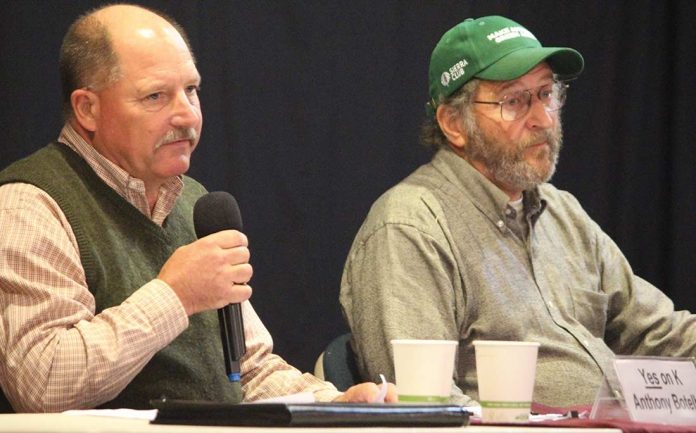
Measure K is emerging as a defining line between growth and slow-growth factions in San Benito County.
County officials advocate potential commercial development along Highway 101 as a way to capture new revenue from sales taxes, while rural landowners and environmentalists warn this would further add traffic, water and other problems for the county.
Measure K, if approved by voters in the March 3 election, would adopt an ordinance approved unanimously by county supervisors in September that converts four properties at highway interchanges to regional commercial zoning.
About 50 people gathered in the Aromas Community Grange Jan. 19 to hear a debate on the measure and pose questions to the two presenters: San Benito County Supervisor Anthony Botelho, who supports the measure, and Andy Hsia-Coron of Preserve Our Rural Communities, who opposes Measure K.
The forum, hosted by the Grange and the League of Women Voters, also included a question-and-answer session with the candidates seeking the District 2 seat on the San Benito County Board of Supervisors left vacant by Botelho’s decision not to seek re-election. Of the five candidates, only one, Kollin Kosmicki, has come out solidly against Measure K. His opponents—Valerie Egland, John Freeman, Wayne Norton and Frank Barragan—have endorsed the zoning change. Barragan did not attend the Sunday panel.
County supervisors approved zoning changes Sept. 24 that were recommended by the county’s 2035 General Plan. But a successful signature-gathering campaign by opponents halted the ordinance’s implementation, putting the question on the March 3 primary ballot, which also features contests in three supervisor districts.
The four interchanges outlined in the ordinance are the Betabel Road and Highway 129/Searle Road interchanges in San Juan Bautista, and the Rocks Ranch and 101 Livestock Market interchanges in Aromas. The four properties, totaling about 326 acres, would be converted to regional commercial zoning, which according to the 2035 General Plan approved in 2015, provides “areas that function as destinations for commercial activity serving the regional population.”
The types of developments allowed are shopping centers, automobile stations and hotels. Under regional commercial zoning, retail space is limited to 85,000 square feet per property.
Opponents of the zoning change say development along Highway 101 would add more traffic in the already congested area, which Botelho disputed. He said the development would instead encourage commuters to get off the highway, alleviating traffic.
“Measure K is not about traffic,” Botelho said. “I don’t believe for one minute that any of these commercial areas will add traffic.”
Hsia-Coron pointed to language in the ordinance that allows up to 30 residential units to be built on each property, as well as 125 hotel rooms, as factors in increasing traffic.
“Every day there is a traffic jam on Highway 101,” he said. “To say this won’t have an impact, go look at Prunedale, see where people merge on and off the highway.”
He said development along the “nodes,” as the properties are referred to, would also negatively impact the Aromas aquifer, as well as wildlife and Amah Mutsun land.
“None of these have been adequately addressed,” Hsia-Coron said.
Botelho said the ordinance requires developers to show proof of a sustainable water source, part of a strict ordinance that also restricts square footage for development while also requiring a “very extensive public review process” for any proposals.
No project applications have been submitted to the county, according to Botelho.
“We can have a business center, we can have stores that sell our local products,” he said. “We could have some gas stations, so we can generate sales tax to fix the roads.
“The county absolutely needs this tax revenue.”
Hsia-Coron said the defeat of Measure K could urge the county to remove the nodes from the General Plan.
The issue of the nodes could play a role in the District 2 election, as all of the properties fall within the district. All candidates during the Jan. 19 forum expressed support for the ordinance, except for Kosmicki, who opposes the development.
Financial data
According to forms filed with the San Benito County Elections Department, the Yes on K committee reported a $22,000 contribution on Jan. 16 from the “Bingaman Irrevocable Trust #1,” which owns the Rocks Ranch property.
It also received $11,000 each from attorneys Gregory N. Weiler and Mark Johnson on Jan. 6. No contributions or expenditures were reported from July 1 to Dec. 31.
The committee, which lists Guadalupe Rangel of Hollister as treasurer, recently announced it had received the endorsement of both the San Benito County Democratic and Republican parties.
Preserve Our Rural Communities, which is listed as the opposing committee to Measure K, received $15,882 in contributions from Jan. 1 to Dec. 31. Contributions ranged from $100 to $1,000 from various individuals.
Aromas residents Ruth Snow, Gina Paolini and Mary Hsia-Coron—who is listed as the principal officer—were among those who donated $1,000.
From July 1 to Dec. 31, the group spent $15,821.10, according to filings. About half that amount—$8,144.66—went to San Francisco-based law firm M.R. Wolfe & Associates for legal services. Preserve Our Rural Communities is currently in litigation with the county over the Highway 101 rezoning decision.
Preserve Our Rural Communities was to host an event at the VFW Hall in San Juan Bautista on Jan. 22, where retired congressman Sam Farr, Amah Mutsun Tribal leader Valentin Lopez and others were scheduled to speak against Measure K.










Friends, What we witness is COG’s Directors’ intentional blindness. We remain the largest urban area on the North American Continent, Silicon & Salinas Valleys combined, without intermodal facilities. We used to have two: one in San Jose at the corner of Taylor & Coleman Ave (the piggyback ramp I supervised on the Graveyard Shift 1966-70), and the one in downtown Salinas near the Amtrak depot, both operated by SPRR’s subsidiary Pacific Motor Trucking. But, since we got unelected “Authorities” stuck on taxpayers’ backs, e.g., COG, VTA, TAMC, SCCRTC, etc., we went from having transportation planned by people who know transportation, to transportation planned by “transit first” radical socialists, who never even consider private-sector transport options. As long as we let our local leaders violate our constitutional rights as they do at COG, VTA, TAMC, etc., then we will not have the positive benefits of private-sector transportation options. At present, EB or WB tonnage flows to and from these two Valleys on the Central California Coast Region have to be drayed to and from the ramps in Lathrop (UPRR) or Stockton (BNSF). As COG calls this “success,” it means greater highway construction and maintenance expenses because axle weight is the largest single factor in road surface and bridge support deterioration. That means COG, VTA, TAMC, SCCRTC, AMBAG, are the largest source of air pollution and highway congestion and delays. But they refuse to even put private-sector solutions on their agendas—I tried to get them to do it for ten years before giving up going to their meetings. They waste millions on empty bus seat transport. They worship “Emperor Transit First,” while sacrificing motorists’ lives. Time to recall all COG’s Directors from their elected posts on SBCBOS and Cities Councils. Caveat viator.
Joseph P. Thompson, Esq.,
Past-Chair, Legislation Committee, Transportation Lawyers Assn.,
408-848-5506; E-Mail: Tr******@*****ll.Net
Charter Member, SBCCOG Citizens Rail Advisory Committee;
Charter Member, SBCCOG Citizens Transit Task Force
Past-President 1999-2001, 2006, Gilroy-Morgan Hill Bar Assn.